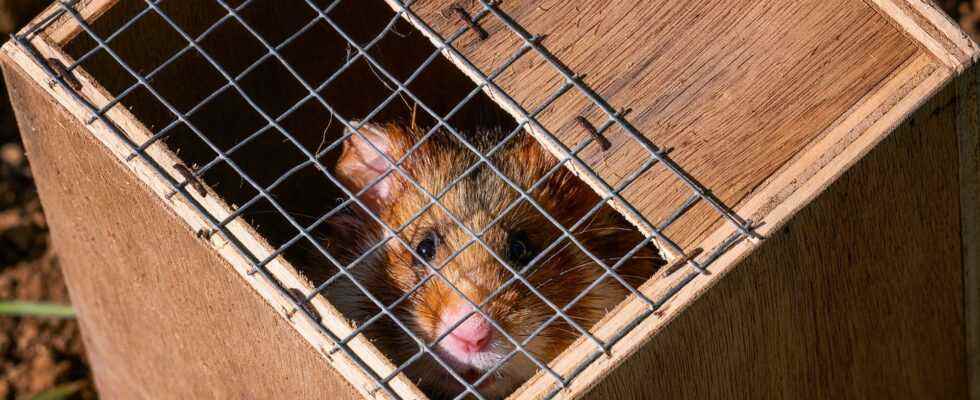A program of reintroduction of the great hamster of Alsace was launched by Vinci, to compensate for a new motorway close to Strasbourg with the controversial environmental impact.
Vinci, which operates a new motorway near Strasbourg with controversial environmental impact, had to commit, to compensate, to a program to reintroduce the common hamster from Alsace, an emblematic species whose habitat is threatened by human activity. .
“I would like everyone to leave with their fingers”: Célia Schapeller smiles as she speaks to one of the press photographers trying to immortalize a little too closely the small mammal with a snout studded with white spots which protrudes wire mesh of the wooden cage from where he waits to be released in this plot of wheat. Under a hard and early sun, 60 large hamsters must be reintroduced that morning.
Clap! The hatch opens, and the “cricetus cricetus”, scientific name of the rodent, falls into the burrow about 80 centimeters deep dug beforehand, immediately covered with agglomerated straw.
“The goal is for them to come out in the evening when there is less risk of raptor attacks,” says Célia Schappeller, a caretaker with the association Sauvage Faune Sauvage (SFS), who raised individuals in captivity in view of this great day.
Also known as the “European hamster”, the animal is listed as “critically endangered” by the International Union for Conservation of Nature. An electric fence is also there to avoid terrestrial predators: foxes, badgers or even cats.
On three hectares, the operation is repeated according to a methodical plan to avoid consanguinity in the burrows and respecting a male-female alternation to encourage fruitful encounters.
“Our operation aims to strengthen the existing populations”, confirms Arnaud Guillemain, the environment manager of Vinci Autoroutes. The releases are a few hundred meters as the crow flies from its new A355, the controversial great western bypass (GCO) of Strasbourg.
“The hamster is a good indicator of the viability of an agricultural system”
This 24-kilometre toll dual carriageway intended to relieve congestion in the Alsatian capital, inaugurated in December after more than 40 years of controversy and local opposition, is the first infrastructure project born with a legal obligation to compensate for the loss of biodiversity. since a 2016 law.
“Having built (the highway) on agricultural plots, in particular with wheat fields which are the habitat of the European hamster, we have compensated on other plots of wheat”, summarizes Mr. Guillemain. This reintegration mechanism initiated in 2017 when work began has already enabled the reintroduction of 800 specimens.
The first group of motorway concessions in France has thus linked up with “dozens of farmers” who undertake not to cultivate corn for 10 years, a culture which drives females to cannibalism, but rather to maintain wheat or standing alfalfa, favorable to “Kornferkel”, the name of the large hamster in Alsatian, literally “little cereal pig”.
An “umbrella” or “sentinel” species, “the hamster is a good indicator of the viability of an agricultural system”, indicates Timothée Gérard, 25, whose thesis in biology, carried out with the CNRS and the University of Strasbourg, is financed by Vinci Autoroutes. “Current field treatments”, linked to conventional agriculture, mean that there is “a fairly significant reduction in soil quality, with insect communities disappearing”.
“An anachronistic communication operation”
“The hamster did not wait for the highway to disappear! It was the monoculture of corn and the pesticides that screwed us up,” Jean-Paul Burget annoys. The emblematic president of SFS, who had France condemned by the European Court of Justice in 2011 because it was not doing enough to protect the animal, believes that the GCO’s compensation measures ultimately allow “a renewal of biodiversity”.
Obliged to reduce the impact of its work, Vinci has also built buried or elevated passages so that wildlife, including the European hamster, can cross the highway, even if Mr. Gérard admits the “low dispersal capacity” of the animal, a few hundred meters only, “unlike the stork”, a successful reintroduction in Alsace.
“These release operations do not make it possible to reconstitute a sufficient population core”, regrets Stéphane Giraud, director of the Alsace Nature association who denounces “an anachronistic communication operation”, and “counting results which are not at the rendezvous -you”.
In Alsace, 488 burrows had been identified in 2021 by the French office for biodiversity, it would take three times more for the species to survive according to the national action plan. “Something is wrong with the reintroduction methodology, while the species has been protected since 1993,” adds Mr. Giraud, who pleads for micro-plots and a review of the facilities.
Last January, an opinion from the Environmental Authority had shredded the impact of the environmental study of the GCO presented by Vinci.
